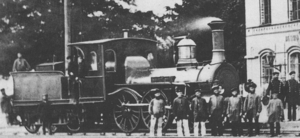This article relies largely or entirely on a single source .(September 2016) |
| Mecklenburg II | |||
|---|---|---|---|
 | |||
| Numbering: | 43, 44, 47–53 1895: 2, 6–8 | ||
| Quantity: | 5 | 1 | 3 |
| Manufacturer: | Borsig | ||
| Years of manufacture: | 1849–1851 | 1851 | 1853+1856 |
| Retired: | 1894–1901 | 1896 | 1891+1893 |
| Wheel arrangement: | 2-4-0 | ||
| Axle arrangement: | 1B n2 | ||
| Track gauge: | 1,435 mm (4 ft 8+1⁄2 in) | ||
| Length over buffers: | ≈ 12,095 mm | ||
| Height: | ≈ 4,422 mm | ||
| Overall wheelbase: | ≈ 3,725 mm | ||
| Unladen weight: | 22.80 t | 24.00 t | 24.20 t |
| Service weight: | 25.05 t | 26.75 t | 26.60 t |
| Adhesive weight: | 15.60 t | 21.95 t | 21.20 t |
| Axle load: | 7.80 t | 10.98 t | 10.60 t |
| Coupled wheel diameter: | 1,535-1,600 mm | ||
| Carrying wheel diameter: | 1,015-1,045 mm | ||
| Valve gear: | Stephenson | ||
| No. of cylinders: | 2 | ||
| Cylinder bore: | 330 mm 356 mm [1] | 380 mm | 381 mm |
| Piston stroke: | 508 mm 559 mm [1] | 559 mm | 559 mm |
| Boiler overpressure: | 8.19 bar 7.31 bar [2] | 7.31 bar | 5.85 bar |
| No. of heating tubes: | 135-143 | 145 | 139 |
| Heating tube length: | 2,794–3,058 mm | 4,077 mm | 4,193 mm |
| Grate area: | 1.07-1.15 m² | 1,07 m² | 0.99 m² |
| Radiative heating area: | 5.15-5.93 m² | 5.57 m² | 5.16 m² |
| Heating tube area: | 48.72-53.51 m² | 80.58 m² | 76.90 m² |
| Evaporative heating area: | 53.87-58.87 m² | 86.15 m² | 82.06 m² |
| Brake: | Screw brake (Spindelbremse) | ||
The Grand Duchy of Mecklenburg Friedrich-Franz Railway grouped various 2-4-0 steam locomotives built between 1849 and 1856 into its Class II. These included five locomotives that had originally been delivered with a 2-2-2 wheel arrangement.